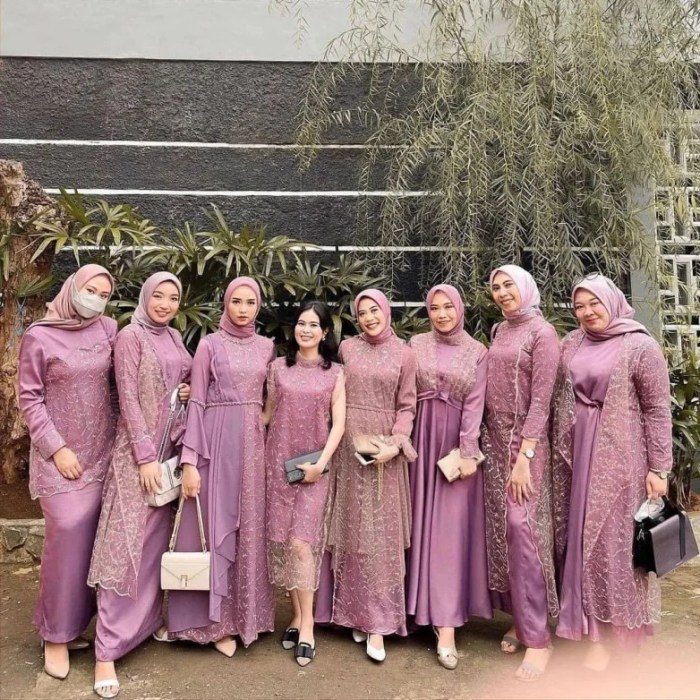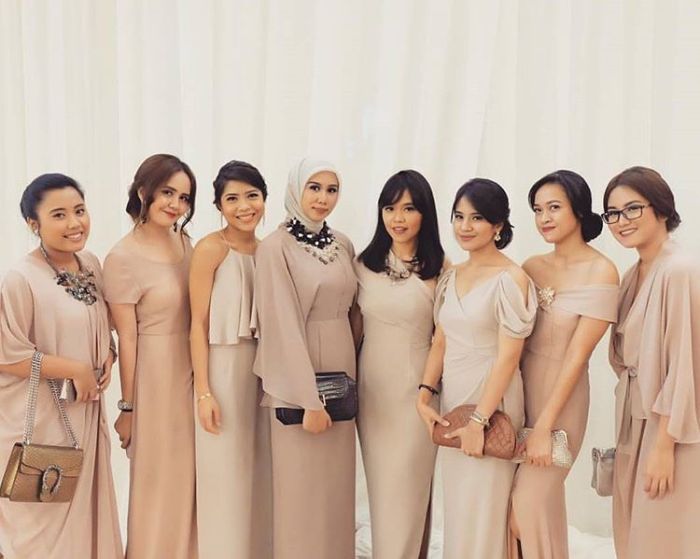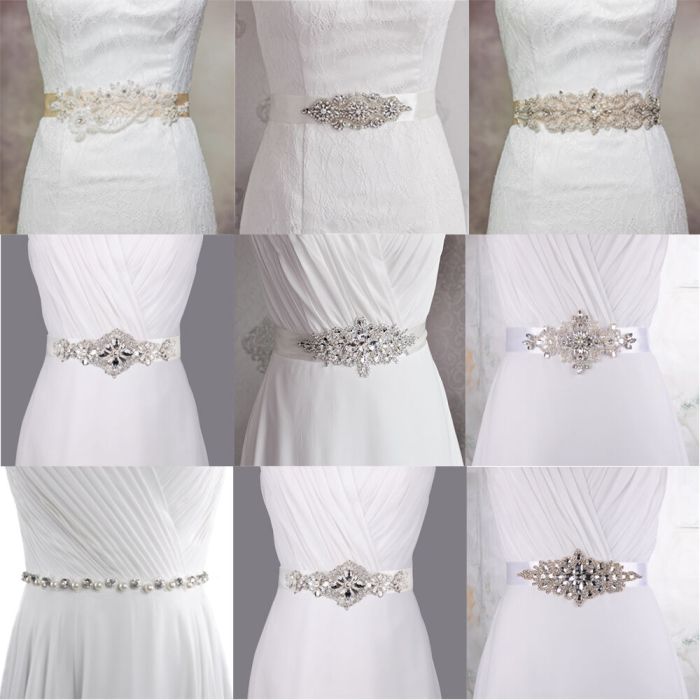Styles and Trends in Bridesmaid Dresses
Wedding dress of bridesmaid – Bridesmaid dress styles have undergone a significant evolution over the decades, reflecting broader fashion trends and the evolving preferences of brides and their bridal parties. This section explores the key shifts in design, color, and fabric choices, highlighting current trends and notable examples from recent high-profile weddings.
Bridesmaid Dress Styles Across Decades
| Style | 1990s | 2000s | 2010s | 2020s |
|---|---|---|---|---|
| A-line | Popular, often with puff sleeves or sweetheart necklines | Remained popular, with variations in fabric and embellishments | Continued prominence, often paired with simpler necklines | Still a classic choice, often in flowing fabrics |
| Mermaid | Less common, primarily for formal weddings | Gained popularity, especially in luxurious fabrics | Became a more versatile option, available in various fabrics and colors | Remains a stylish choice, often with modern twists |
| Empire Waist | Seen in some weddings, often with flowing fabrics | Less prevalent, but still a choice for certain body types | Experienced a resurgence, particularly in bohemian-style weddings | Continues to be a flattering option for various body types |
Evolution of Bridesmaid Dress Colors and Fabrics
Over the past 20 years, bridesmaid dress colors have transitioned from predominantly pastel shades to a wider range of hues, including bold jewel tones and even metallics. Fabric choices have also diversified, moving beyond traditional materials like satin and taffeta to include more comfortable and versatile options.
The early 2000s saw a preference for muted pastels like blush pink, lavender, and mint green. The mid-2010s brought a surge in jewel tones like emerald green, sapphire blue, and ruby red. Currently, the trend leans towards a mix of classic neutrals (such as ivory and champagne) and vibrant colors, often customized to complement the wedding’s overall palette.
Fabric-wise, chiffon and satin remained staples, but newer options like crepe, lace, and even velvet have gained traction. The choice often depends on the season, formality of the wedding, and the desired aesthetic.
Current Trends in Bridesmaid Dress Silhouettes and Necklines
Modern bridesmaid dresses showcase a variety of silhouettes and necklines, reflecting a move towards individuality and comfort. Popular silhouettes include A-line, fit-and-flare, and tea-length gowns, offering diverse options for various body types. Necklines range from classic V-necks and scoop necks to more contemporary options like square necks and one-shoulder styles.
Recent high-profile weddings have featured unique designs, such as dresses with statement sleeves, intricate back details, and subtle embellishments. The emphasis is on creating a cohesive yet stylish look that allows each bridesmaid to feel comfortable and confident.
Innovative and Unique Bridesmaid Dress Designs
Recent high-profile weddings have showcased innovative designs, including dresses with detachable sleeves or skirts, allowing for versatility. Some have incorporated unique embellishments like delicate beading, embroidery, or even bold prints. The overall trend is towards personalization, allowing bridesmaids to choose styles that best suit their individual preferences while maintaining a cohesive bridal party look. For instance, the wedding of [Name of Celebrity] featured bridesmaids in [description of dress style and unique features], creating a memorable and stylish aesthetic.
Fabric and Material Choices
The choice of fabric significantly impacts the look, feel, and overall cost of bridesmaid dresses. Understanding the properties of different fabrics is crucial for selecting the most appropriate option for the wedding season, venue, and desired aesthetic.
Common Fabrics for Bridesmaid Dresses
- Chiffon: Lightweight, sheer, and flowing; ideal for warmer weather but may require a slip underneath. Relatively inexpensive.
- Satin: Luxurious, smooth, and shiny; can be more expensive and may wrinkle easily. Suitable for formal weddings.
- Lace: Elegant and intricate; can be delicate and require careful handling. Cost varies depending on the type and quality of lace.
- Crepe: Durable, matte, and drapes well; a versatile option suitable for various seasons and styles. Moderately priced.
- Velvet: Rich, luxurious, and warm; ideal for colder months but can be heavy and less breathable.
Fabric Drape and Texture Comparison
Chiffon and crepe offer a soft, flowing drape, while satin has a smoother, more structured drape. Lace adds texture and visual interest, while crepe provides a more matte and subtle texture. The choice depends on the desired level of formality and the overall aesthetic.
Fabric Suitability for Different Seasons and Climates
Lightweight fabrics like chiffon and cotton are ideal for warmer climates, while heavier fabrics like velvet and brocade are better suited for colder months. Consider the wedding venue and season when selecting fabrics to ensure the bridesmaids remain comfortable.
Impact of Fabric Choice on the Overall Look
Fabric choice significantly impacts the overall look and feel of the bridesmaid dress. A flowing chiffon dress creates a romantic and ethereal look, while a structured satin dress conveys elegance and sophistication. Lace adds a touch of vintage charm, while crepe offers a modern and versatile option.
Color and Style Coordination with the Wedding Theme: Wedding Dress Of Bridesmaid
Coordinating bridesmaid dress colors and styles with the overall wedding theme is crucial for creating a cohesive and visually appealing look. This involves considering the wedding venue, season, and the bride’s dress style.
Bridesmaid Dress Colors and Wedding Themes
| Wedding Theme | Suitable Colors | Example Color Palette | Notes |
|---|---|---|---|
| Rustic | Earthy tones, jewel tones | Burgundy, sage green, blush pink | Consider natural fabrics like linen or cotton. |
| Beach | Pastel shades, light blues, corals | Light blue, coral, ivory | Choose lightweight, breathable fabrics. |
| Formal | Deep jewel tones, metallics, neutrals | Navy blue, emerald green, champagne | Luxurious fabrics like satin or velvet are appropriate. |
Color Palettes and Wedding Dress Styles
A classic white wedding dress pairs well with a range of colors, from soft pastels to bold jewel tones. A blush-colored wedding dress might complement dusty rose, mauve, or even navy blue bridesmaid dresses. The key is to create a visually harmonious palette.
Considering Wedding Venue and Season

Source: weddingmarket.com
The wedding venue and season heavily influence color choices. A summer beach wedding might call for light and airy pastel shades, while a fall wedding might be complemented by warm autumnal hues. The venue’s architecture and ambiance should also be considered.
Coordinating with Other Wedding Elements
For a cohesive look, coordinate bridesmaid dress colors with the wedding flowers, decorations, and even the stationery. Using similar shades or complementary colors creates a unified aesthetic that ties all the elements together.
Budget and Shopping Considerations
Finding affordable bridesmaid dresses without compromising on quality requires careful planning and a strategic approach. This section explores various shopping strategies and cost considerations to help you make informed decisions.
Tips for Finding Affordable Bridesmaid Dresses
- Shop during off-season sales or clearance events.
- Consider less expensive fabrics like chiffon or crepe.
- Opt for simpler designs with minimal embellishments.
- Look for online retailers that offer competitive pricing.
- Consider renting dresses instead of buying them.
Online vs. In-Store Purchasing
Online shopping offers convenience and wider selection, but lacks the ability to try dresses on before purchasing. In-store shopping allows for try-ons and personalized assistance, but may have limited selection and higher prices.
Renting vs. Buying Bridesmaid Dresses, Wedding dress of bridesmaid
Renting offers cost savings, especially for one-time wear. Buying provides ownership and potential resale value. The best option depends on budget and long-term needs.
Typical Costs Associated with Bridesmaid Dresses
The cost of bridesmaid dresses varies widely depending on fabric, style, and retailer. Expect to budget for the dress itself, alterations (if needed), accessories, and potentially shipping costs.
Accessorizing Bridesmaid Dresses
Accessories play a crucial role in enhancing the look of bridesmaid dresses, adding personality and complementing the overall wedding style. Careful selection of accessories can elevate the entire bridal party’s appearance.
Accessories to Enhance Bridesmaid Dresses

Source: hipwee.com
- Jewelry: Necklaces, earrings, bracelets, and rings can add a touch of elegance or sparkle.
- Shoes: Heels, flats, or sandals should complement the dress style and the wedding venue.
- Wraps or shawls: Provide warmth and style, especially for outdoor or evening weddings.
- Hair accessories: Headbands, hairpins, or flowers can add a touch of sophistication or whimsy.
- Handbags or clutches: Practical and stylish, matching the overall aesthetic.
Accessories and Dress Styles/Body Types
Accessories should complement the dress style and the bridesmaids’ body types. A simple necklace might be ideal for a dress with a statement neckline, while a bold bracelet could enhance a simpler dress. Consider the overall silhouette and the bridesmaids’ preferences.
Creative and Unique Ways to Accessorize
Consider personalized touches like monogrammed jewelry, unique hair accessories, or colorful scarves. These details add a personal touch and create a cohesive yet individualized look for the bridal party.
Considering the Overall Wedding Style
Accessories should reflect the overall wedding style. A rustic wedding might call for simple, natural accessories, while a formal wedding might benefit from elegant jewelry and sophisticated clutches.
Ethical and Sustainable Choices
Increasingly, brides are prioritizing ethical and sustainable choices when selecting bridesmaid dresses. This section explores the benefits of eco-conscious options and provides resources for finding them.
Benefits of Ethical and Sustainable Bridesmaid Dresses
Choosing ethically sourced and sustainably produced dresses supports fair labor practices, reduces environmental impact, and promotes transparency in the fashion industry. It aligns with a growing awareness of the social and environmental costs of fast fashion.
Brands Prioritizing Ethical and Sustainable Practices
Several brands focus on ethical and sustainable practices in bridesmaid dress production. Researching brands committed to fair wages, safe working conditions, and eco-friendly materials is crucial. Look for certifications and transparent sourcing information.
Environmental Impact of Fabrics and Manufacturing Processes
Different fabrics have varying environmental impacts. Organic cotton, linen, and recycled materials are more sustainable than synthetic fabrics. Manufacturing processes, such as water usage and waste generation, also play a significant role.
Resources for Finding Eco-Friendly Options
Numerous online resources and directories showcase brands committed to ethical and sustainable fashion. Look for retailers and designers who prioritize transparency and responsible sourcing.
Illustrative Examples of Bridesmaid Dress Designs
Three Different Bridesmaid Dress Designs (Fabric, Color, Silhouette, Accessories)
Design 1: A flowing A-line gown in blush pink chiffon, featuring delicate spaghetti straps and a subtle empire waist. Accessories: Delicate pearl necklaces and simple silver sandals. Aesthetic: Romantic and ethereal, suitable for a garden or beach wedding.
Choosing bridesmaid dresses requires careful consideration of the overall wedding aesthetic. If a bold color scheme is desired, incorporating a vibrant hue like red can create a striking visual impact. For inspiration on achieving this look, you might find a wealth of options by checking out this site featuring red dresses for wedding , which offers various styles and shades.
Ultimately, the bridesmaid dresses should complement the bride’s gown while maintaining a cohesive and stylish ensemble for the wedding party.
Design 2: A sleek, column gown in navy blue crepe, with a high neckline and a subtle slit. Accessories: Statement earrings and elegant black heels. Aesthetic: Sophisticated and chic, ideal for a formal city wedding.
Design 3: A midi-length fit-and-flare dress in emerald green velvet, featuring a V-neck and three-quarter sleeves. Accessories: Gold statement necklaces and ankle-strap heels. Aesthetic: Elegant and luxurious, perfect for a winter wedding.
Three Different Bridesmaid Dress Designs (Unique Embellishments and Detailing)
Design 1: A champagne-colored gown adorned with intricate lace appliqués, creating a vintage-inspired look. Technique: Hand-sewn lace appliqués. Impact: Adds a touch of elegance and romance.
Design 2: A deep red dress featuring hand-beaded embroidery along the neckline and bodice. Technique: Intricate beadwork. Impact: Creates a glamorous and luxurious feel.
Design 3: A blush pink gown with strategically placed floral appliqués, adding a touch of whimsy and personality. Technique: Embroidered floral appliqués. Impact: Creates a romantic and playful aesthetic.
Three Different Bridesmaid Dress Designs (Complementing Different Body Types)
Design 1 (Hourglass): A fit-and-flare dress accentuates the waistline and balances the proportions. Alterations: Minor adjustments to the waistline for a perfect fit.
Design 2 (Pear): An A-line dress balances wider hips with a fitted bodice. Alterations: Slight adjustments to the shoulders to create a more flattering neckline.
Design 3 (Rectangle): An empire waist dress creates the illusion of curves. Alterations: Adding a belt or sash to define the waist.
General Inquiries
Can bridesmaids wear different styles of dresses?
Yes, allowing bridesmaids to choose a style that flatters their body type while maintaining a cohesive color palette is increasingly popular.
How far in advance should bridesmaid dresses be ordered?
Ideally, 6-8 months in advance to allow for alterations and potential shipping delays.
What if a bridesmaid’s dress doesn’t fit perfectly?
Budget for alterations; a good seamstress can adjust the dress for a perfect fit.
Are there options for plus-size bridesmaids?
Yes, many retailers offer extended sizing or custom-made options for plus-size bridesmaids.

